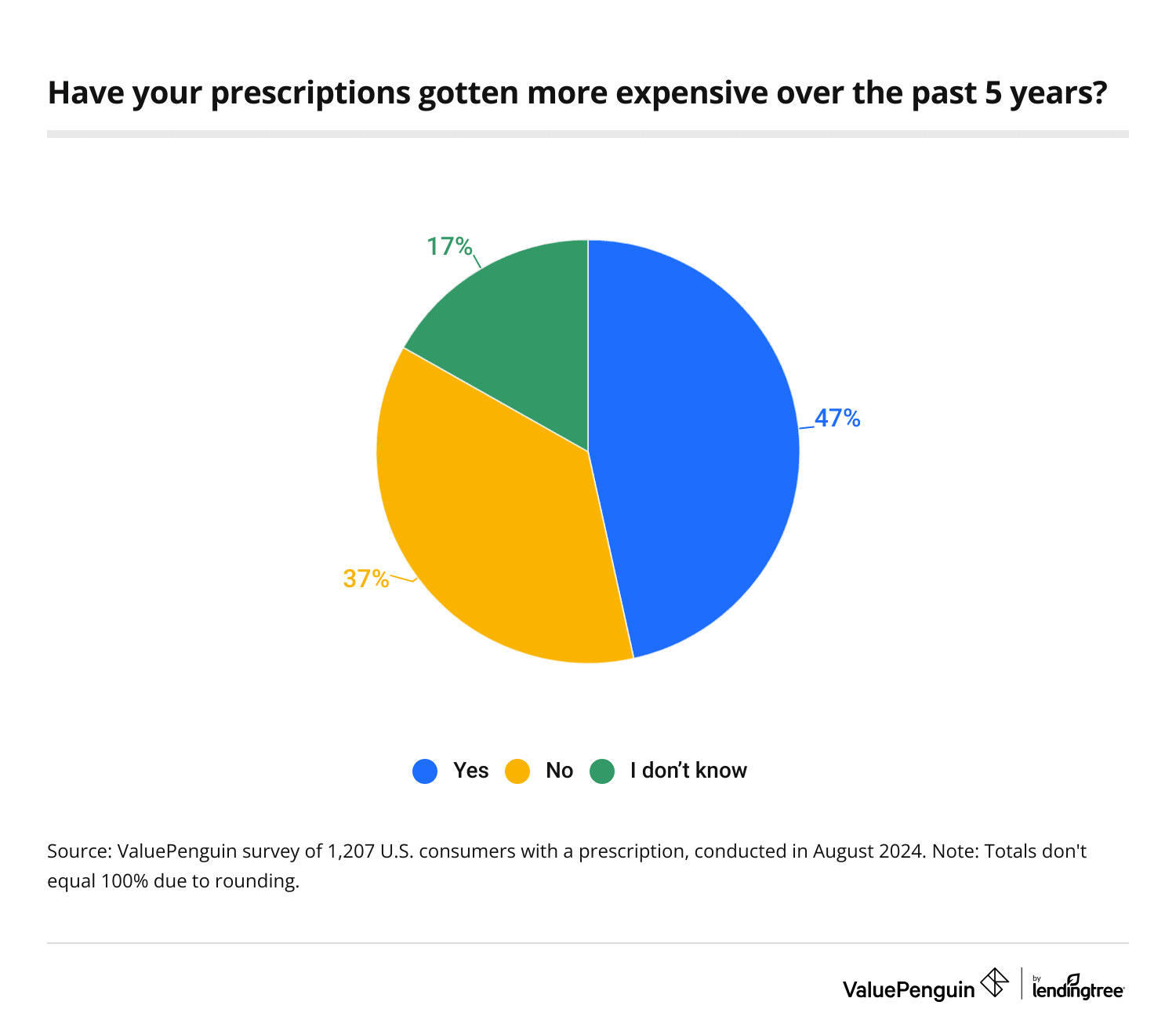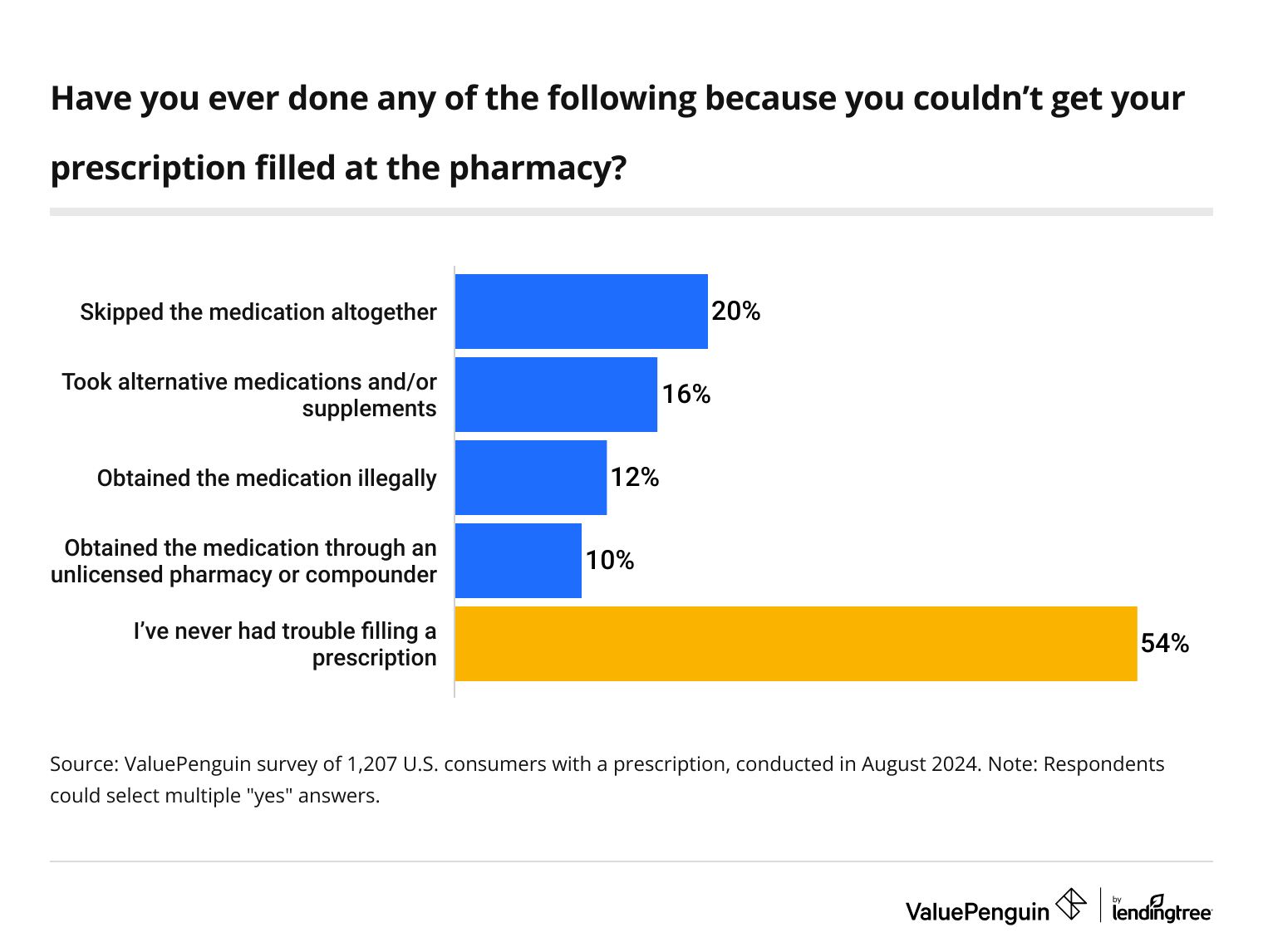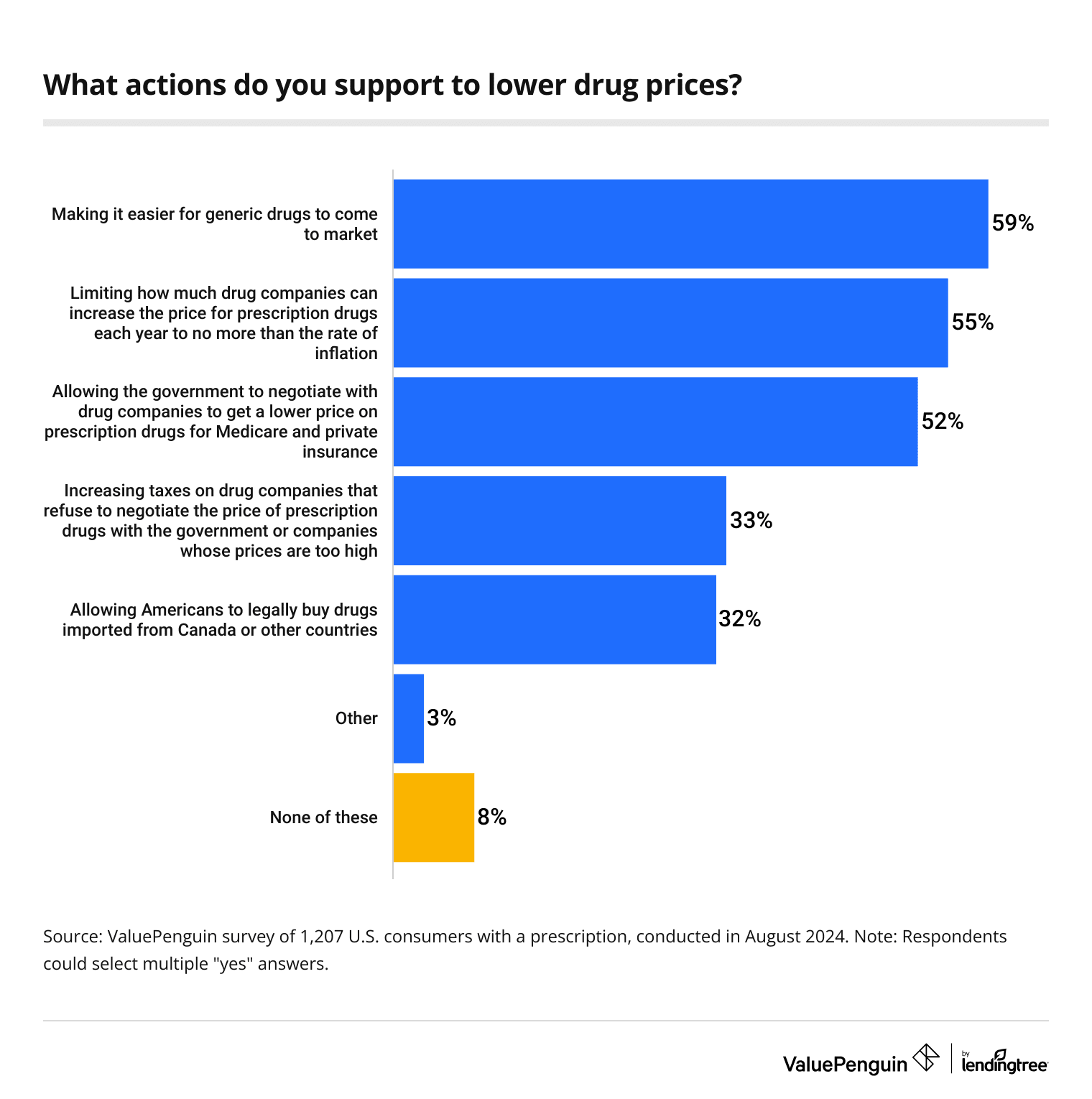Health Insurance
State of Prescriptions in 2024: Shortages and Rising Prices

Modern medicine may be more accessible than ever, but getting your hands on prescriptions may be a frustrating (and expensive) challenge as supply chains struggle and prices soar.
According to the latest ValuePenguin survey of over 2,000 U.S. consumers, just over a quarter (26%) of prescription-takers have had difficulty filling a prescription in the past year. And 47% say their prescriptions have gotten more expensive over the past five years.
After detailing our findings, we’ll discuss tips on utilizing health insurance to get by during a medication shortage.
On this page
Key findings
- Consumers struggle with drug shortages and rising costs. 26% of Americans with a prescription say they’ve had difficulty filling one in the past year, with 70% of them reporting waiting at least a week. Additionally, over half (52%) with a prescription believe shortages are becoming more common, and 47% say their prescriptions have gotten more expensive over the past five years.
- Americans face negative effects from skipping medications. Almost 1 in 4 (24%) with a prescription say they skipped one in the last year, with 64% of them reporting their health was negatively impacted. Additionally, some Americans with prescription shortages resorted to somewhat dangerous sources, including buying their medications illegally (12%) or from an unlicensed pharmacy or compounder (10%).
- Almost half (48%) of Americans with a prescription say pharmaceutical companies should take the primary blame for drug shortages, while 20% cite insurance companies. While just 19% believe the government is primarily to blame, 80% with a prescription believe the federal government should do more to ensure prescriptions are readily available.
- Many agree on the ways to alleviate these problems. Most Americans with a prescription support solutions such as making generic drugs more readily available (59%), limiting drug price hikes to no more than the rate of inflation (55%) and allowing the government to negotiate drug prices (52%).
Americans face hurdles in getting prescriptions filled
Many Americans rely on a prescription, with nearly 3 in 5 (59%) taking one.
With that in mind, 26% of Americans with a prescription say they’ve had difficulty getting their medication filled in the past year. That’s particularly true among Gen Zers ages 18 to 27 with a prescription (44%), millennials ages 28 to 43 (39%) and those with children younger than 18 (39%). Additionally, men with a prescription (31%) are more likely to face difficulty filling one than women (22%).
Of those struggling to get medication filled, 48% waited between one week and one month for their medication — the most common response. Meanwhile, 30% waited less than a week. Beyond that:
- 16% waited between one and three months
- 5% waited longer than three months
A significant 52% of Americans with a prescription believe shortages are becoming more common. They’re not wrong: According to the American Society of Health-System Pharmacists (ASHP), active drug shortages reached an all-time high of 323 in the first quarter of 2024. While that number fell to 300 in the second quarter of 2024, it’s still significant.
ValuePenguin health insurance expert Divya Sangameshwar says this isn’t a new problem. "While the COVID-19 pandemic exacerbated the situation, ongoing drug shortages have risen to their highest levels in years," she says. "While some shortages resolve fairly quickly, some drugs have been experiencing shortages for decades."
Beyond shortages, 47% say their prescriptions have gotten more expensive over the past five years, and 64% worry their prescriptions will continue to rise in cost over the next five years. Between January 2022 and 2023, 46% of prescription drugs with price increases saw hikes that exceeded inflation rates, according to the Assistant Secretary for Planning and Evaluation (ASPE) Office of Health Policy.

Costs may be a burden, but many Americans don’t make an effort to save. In fact, according to a 2023 ValuePenguin survey on prescription costs, just 31% of Americans have used an online pharmacy despite many saying that doing so was cheaper. Additionally, just 33% of Americans have switched pharmacies to take advantage of lower costs.
Despite price increases, 82% of Americans with a prescription find their medications affordable, with 89% of prescription-takers spending under $100 a month on them. And 23% don’t spend any money on their medication.
Meanwhile, 36% of insured Americans with a prescription have previously chosen not to use their insurance because it was cheaper to buy it as an uninsured patient.
Related: Pharmaceutical spending is up 77% over 10 years, yet out-of-pocket prescription drug costs have fallen in the same period
Skipping medication has consequences
Although they might not have a choice, Americans face negative effects from skipping medications. Skipping a dose (or more) due to lack of availability is unfortunately common, with 24% of prescription-takers having done so in the past year. That’s especially true among Gen Zers (40%), those with children younger than 18 (38%) and millennials (34%).
Of this group, 64% say it negatively impacted their health. Because of this, Sangameshwar says it’s important to discuss what to do during a drug shortage with your health care provider.
"Skipping prescriptions can set back the treatment plan doctors may have put in place for their patients," she says. "It can increase the time it takes for their patients to recover and even complicate or worsen the chronic condition those medications were intended to treat. While it can be tempting to skip prescriptions to save or avoid an alternative you aren’t sure about, it’s best not to make these decisions without consulting your health care providers."
Some are willing to go to great lengths to avoid skipping a dose — at an even greater risk. Among prescription-takers, 12% bought a medication illegally and 10% bought from an unlicensed pharmacy or compounder.

Americans most likely to blame pharmaceutical companies for shortages
Who’s to blame for a drug shortage? Of those with a prescription, 48% mainly blame pharmaceutical companies, 20% blame insurance companies and 19% blame the government.

Baby boomers ages 60 to 78 with a prescription are particularly likely to blame pharmaceutical companies, at 65%. Meanwhile, blaming the government becomes more prevalent among Gen Z and millennial Americans with a prescription, at 28% and 25%, respectively.
Regardless of who they blame, 80% with a prescription believe the federal government should do more to ensure prescriptions are readily available. This is most common among those earning $50,000 to $99,999 annually (84%).
Prescription-takers want more generic options, price hike limits
As for potential solutions, most Americans with a prescription are in agreement. Of those taking a prescription, 59% support making generic drugs more readily available — the most common response. Meanwhile, 55% support limiting drug price hikes to no more than the rate of inflation and 52% support allowing the government to negotiate drug prices.

Baby boomers in particular are enthusiastic about increasing generic drug availability, with 73% supporting this measure.
As far as politics go, Americans with a prescription are more likely to say Democrats (45%) do a better job at controlling drug prices than Republicans (25%), though this comes with a caveat. More than 8 in 10 (84%) Democratic respondents say their party does better, while 70% of Republican respondents say their party does. Meanwhile, 30% of respondents with a prescription say neither does a good job of controlling drug prices.
Riding a shortage wave: Top expert tips
Facing a shortage can be very frustrating and scary, but Sangameshwar says most Americans have some options. Here are a few steps to consider:
- Research alternatives. "Ask your pharmacist to recommend alternatives (like a similar drug or a new treatment option) and discuss them with your health care provider," Sangameshwar says. "Also, make sure your insurance covers it if you choose an alternative drug."
- Appeal for coverage exceptions. If you’re struggling to find an in-network option during a shortage, don’t hesitate to request a coverage exception from your insurance company. It may approve out-of-network providers or medications not typically covered in your plan.
- Check multiple pharmacies. "While your usual pharmacy may be out of stock, the drug you need could be available from a different chain, independent pharmacy or online pharmacy," Sangameshwar says. "This strategy can be very helpful to save money, especially for those whose insurance companies won’t cover the cost of their new prescription."
- Keep an eye on your deductible. In times of shortages, costs can fluctuate, potentially pushing you closer to meeting your deductible. While those out-of-pocket costs may be a momentary burden, reaching your deductible could mean greater coverage and better savings.
Methodology
ValuePenguin commissioned QuestionPro to conduct an online survey of 2,050 U.S. consumers ages 18 to 78 from Aug. 1 to 5, 2024. The survey was administered using a nonprobability-based sample, and quotas were used to ensure the sample base represented the overall population. Researchers reviewed all responses for quality control.
We defined generations as the following ages in 2024:
- Generation Z: 18 to 27
- Millennial: 28 to 43
- Generation X: 44 to 59
- Baby boomer: 60 to 78
